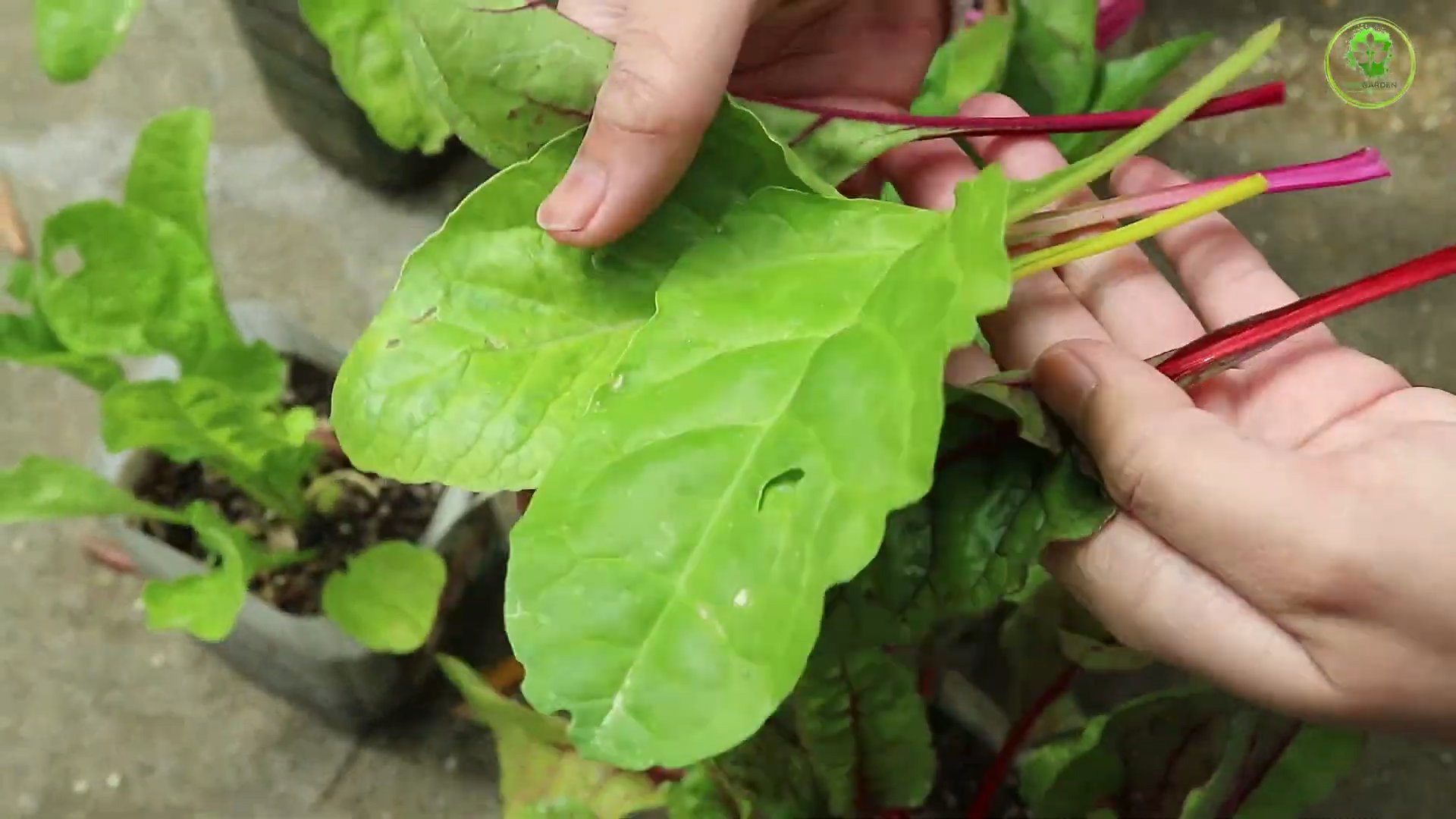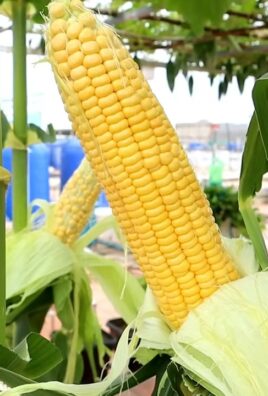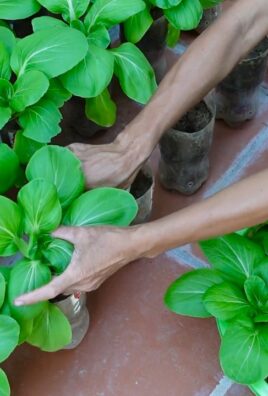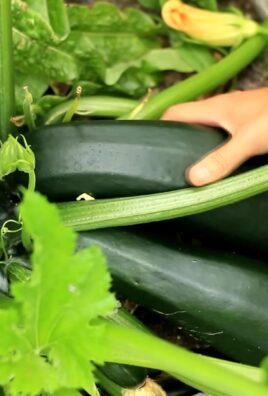Grow Swiss Chard Indoors? Absolutely! Imagine fresh, vibrant Swiss chard gracing your plate, even when the snow is falling outside. Forget those bland, store-bought greens – with a few simple tricks, you can cultivate your own delicious and nutritious Swiss chard right in the comfort of your home.
For centuries, leafy greens like Swiss chard have been a staple in diets around the world, prized for their health benefits and versatility in the kitchen. From hearty soups to vibrant salads, Swiss chard adds a burst of flavor and essential vitamins. But what if you don’t have a sprawling garden or the perfect outdoor climate? That’s where the magic of indoor gardening comes in!
I know what you’re thinking: “Indoor gardening sounds complicated!” But trust me, it doesn’t have to be. This DIY guide is packed with easy-to-follow steps and clever hacks to help you successfully grow Swiss Chard Indoors, no matter your experience level. We’ll cover everything from choosing the right container and soil to providing the perfect amount of light and water.
Why should you bother with this DIY project? Because fresh, homegrown produce is simply better! You’ll enjoy superior flavor, avoid harmful pesticides, and save money on grocery bills. Plus, nurturing your own plants is incredibly rewarding and therapeutic. So, let’s get our hands dirty and embark on this exciting indoor gardening adventure together!

Growing Swiss Chard Indoors: A Beginner’s Guide
Hey there, fellow plant enthusiasts! Ever thought about growing your own vibrant, nutritious Swiss chard right inside your home? It’s easier than you might think, and trust me, nothing beats the taste of freshly harvested greens you’ve nurtured yourself. I’m going to walk you through everything you need to know to successfully grow Swiss chard indoors, from seed to harvest. Let’s get started!
Choosing the Right Variety
First things first, let’s talk about varieties. While most Swiss chard varieties will grow indoors, some are better suited than others due to their size and growth habits. Here are a few of my favorites:
* Bright Lights: This is a popular choice for its colorful stems, ranging from red and yellow to orange and pink. It’s also relatively compact, making it ideal for indoor growing.
* Fordhook Giant: As the name suggests, this variety can get quite large, but it’s still manageable indoors, especially if you provide a large enough container. It’s known for its dark green, heavily textured leaves.
* Lucullus: This is a reliable and productive variety with crinkled, light green leaves. It’s a good all-around choice for indoor growing.
Gathering Your Supplies
Before you start planting, you’ll need to gather all the necessary supplies. Here’s a checklist to make sure you have everything:
* Swiss Chard Seeds: Choose your favorite variety from the list above or experiment with a few different ones!
* Containers: You’ll need containers that are at least 6-8 inches deep and wide. I prefer using pots that are 12 inches deep and wide to give the roots plenty of room to grow. Make sure the containers have drainage holes to prevent waterlogging.
* Potting Mix: Use a high-quality, well-draining potting mix. Avoid using garden soil, as it can compact and not drain well in containers.
* Grow Lights (Optional but Recommended): While Swiss chard can tolerate some shade, it thrives with plenty of light. If you don’t have a sunny windowsill, consider using grow lights to supplement the natural light.
* Watering Can or Spray Bottle: For watering your seedlings and mature plants.
* Fertilizer: A balanced liquid fertilizer, such as a 10-10-10 or 20-20-20, will help your Swiss chard grow strong and healthy.
* Seed Starting Tray (Optional): If you prefer to start your seeds indoors before transplanting them to larger containers.
Planting Your Swiss Chard Seeds
Now for the fun part – planting! Here’s how to get your Swiss chard seeds started:
1. Soaking the Seeds (Optional): Soaking your Swiss chard seeds in water for 2-4 hours before planting can help speed up germination. This softens the seed coat and allows water to penetrate more easily.
2. Filling the Containers: Fill your containers with potting mix, leaving about an inch of space at the top. Gently pat down the soil to remove any air pockets.
3. Sowing the Seeds: Sow the seeds about ½ inch deep and 1-2 inches apart. If you’re using a seed starting tray, sow one seed per cell.
4. Watering: Gently water the soil until it’s evenly moist but not soggy.
5. Providing Light: Place the containers in a sunny windowsill or under grow lights. If using grow lights, position them a few inches above the soil surface.
6. Maintaining Moisture: Keep the soil consistently moist but not waterlogged. You can cover the containers with plastic wrap or a humidity dome to help retain moisture.
7. Germination: Swiss chard seeds typically germinate in 5-10 days. Once the seedlings emerge, remove the plastic wrap or humidity dome.
Caring for Your Swiss Chard Plants
Once your Swiss chard seedlings have emerged, it’s time to provide them with the care they need to thrive.
1. Thinning the Seedlings: If you sowed multiple seeds per container, thin the seedlings to one plant per container once they have a few sets of true leaves. Choose the strongest and healthiest-looking seedling and gently snip off the others at the soil line.
2. Watering: Water your Swiss chard plants regularly, keeping the soil consistently moist but not waterlogged. Water when the top inch of soil feels dry to the touch.
3. Fertilizing: Fertilize your Swiss chard plants every 2-3 weeks with a balanced liquid fertilizer. Follow the instructions on the fertilizer label for proper dilution rates.
4. Providing Light: Swiss chard needs at least 6 hours of sunlight per day. If you don’t have a sunny windowsill, use grow lights to supplement the natural light.
5. Temperature: Swiss chard prefers temperatures between 60-75°F (15-24°C). Avoid exposing your plants to extreme temperatures.
6. Air Circulation: Good air circulation is important for preventing fungal diseases. Make sure your plants have plenty of space around them and consider using a small fan to improve air circulation.
7. Pest Control: Keep an eye out for common pests such as aphids, spider mites, and whiteflies. If you notice any pests, treat them with insecticidal soap or neem oil.
Harvesting Your Swiss Chard
The best part of growing your own Swiss chard is, of course, harvesting and enjoying your fresh greens!
1. When to Harvest: You can start harvesting Swiss chard leaves when they are about 6 inches long.
2. How to Harvest: Harvest the outer leaves first, leaving the inner leaves to continue growing. You can harvest individual leaves or cut the entire plant about an inch above the soil line. The plant will regrow and produce more leaves.
3. Harvesting Regularly: Harvesting regularly encourages the plant to produce more leaves.
4. Storing Your Harvest: Freshly harvested Swiss chard can be stored in the refrigerator for up to a week. Wrap the leaves in a damp paper towel and store them in a plastic bag.
Troubleshooting Common Problems
Even with the best care, you may encounter some problems while growing Swiss chard indoors. Here are a few common issues and how to address them:
* Yellowing Leaves: Yellowing leaves can be caused by overwatering, underwatering, nutrient deficiencies, or pests. Check the soil moisture and adjust your watering accordingly. Fertilize your plants regularly and inspect them for pests.
* Leggy Growth: Leggy growth, where the plants are tall and spindly, is usually caused by insufficient light. Provide your plants with more light by moving them to a sunnier location or using grow lights.
* Pests: Common pests such as aphids, spider mites, and whiteflies can infest Swiss chard plants. Treat them with insecticidal soap or neem oil.
* Fungal Diseases: Fungal diseases such as powdery mildew can affect Swiss chard plants, especially in humid conditions. Improve air circulation and avoid overwatering. You can also treat the plants with a fungicide.
Extending Your Harvest
Want to keep enjoying fresh Swiss chard for as long as possible? Here are a few tips for extending your harvest:
* Succession Planting: Sow new seeds every few weeks to ensure a continuous supply of Swiss chard.
* Overwintering: In mild climates, you can overwinter your Swiss chard plants indoors. Bring them inside before the first frost and provide them with plenty of light and water.
* Cold Frames: If you have a cold frame, you can use it to protect your Swiss chard plants from frost and extend the growing season.
Enjoying Your Homegrown Swiss Chard
Now that you’ve successfully grown your own Swiss chard indoors, it’s time to enjoy the fruits (or rather, leaves!) of your labor. Swiss chard is a versatile vegetable that can be used in a variety of dishes. Here are a few ideas:
* Sautéed Swiss Chard: Sauté Swiss chard with garlic, olive oil, and a pinch of salt and pepper for a simple and delicious side dish.
* Swiss Chard Salad: Add chopped Swiss chard to your favorite salad for a boost of nutrients and flavor.
* Swiss Chard Soup: Use Swiss chard in soups and stews for added texture and nutrition.
* Swiss Chard Frittata: Add chopped Swiss chard to a frittata or omelet for a healthy and flavorful breakfast or brunch.
* Swiss Chard Smoothies: Blend Swiss chard into your favorite smoothie for a green boost.
Growing Swiss chard indoors is a rewarding experience that allows you to enjoy fresh, nutritious greens year-round. With a little bit of care and attention, you can easily grow your own supply of this versatile vegetable.

Conclusion
So, there you have it! Growing Swiss chard indoors is not only possible, it’s surprisingly rewarding. Forget those wilted, overpriced greens at the grocery store. Imagine stepping into your kitchen and harvesting fresh, vibrant Swiss chard leaves whenever you need them. The deep green, sometimes rainbow-hued, leaves are just a snip away, ready to add a burst of flavor and nutrition to your meals.
This DIY trick is a must-try for several compelling reasons. First, it gives you complete control over the growing environment. You can ensure your Swiss chard receives the optimal amount of light, water, and nutrients, resulting in healthier, more flavorful leaves. Second, it’s incredibly convenient. No more last-minute trips to the store or settling for less-than-perfect produce. Third, it’s a sustainable and eco-friendly way to enjoy fresh greens. You’re reducing your carbon footprint by eliminating transportation and packaging waste. Finally, and perhaps most importantly, it’s incredibly satisfying to nurture a plant from seed to harvest. There’s a unique joy in watching your Swiss chard thrive under your care.
But the fun doesn’t stop there! Feel free to experiment with different varieties of Swiss chard. ‘Bright Lights’ is a popular choice for its colorful stems, while ‘Fordhook Giant’ offers large, robust leaves. You can also try growing Swiss chard in different types of containers, from traditional pots to repurposed buckets or even vertical planters. Consider companion planting with herbs like basil or parsley to enhance the flavor of your Swiss chard and deter pests. Another variation is to adjust the lighting schedule to see if you can optimize leaf production. Some growers have found success by supplementing with red and blue LED grow lights, especially during the shorter days of winter.
Don’t be afraid to get creative and tailor the growing process to your specific needs and preferences. The beauty of growing Swiss chard indoors is that it’s a flexible and adaptable process. Whether you’re a seasoned gardener or a complete beginner, you can successfully grow your own delicious and nutritious Swiss chard.
We wholeheartedly encourage you to give this DIY trick a try. It’s a simple, affordable, and rewarding way to enjoy fresh, healthy greens year-round. And once you’ve harvested your first batch of homegrown Swiss chard, we’d love to hear about your experience! Share your tips, tricks, and photos in the comments below. Let’s build a community of indoor Swiss chard enthusiasts and inspire others to embrace the joy of growing their own food. Remember, the key to success is patience, observation, and a willingness to learn. Happy growing!
Frequently Asked Questions (FAQ)
What kind of soil is best for growing Swiss chard indoors?
A well-draining potting mix is essential for growing Swiss chard indoors. Avoid using garden soil, as it can become compacted and waterlogged in containers. Look for a potting mix that contains a blend of peat moss, perlite, and vermiculite. These ingredients help to improve drainage and aeration, which are crucial for healthy root growth. You can also amend your potting mix with compost or other organic matter to provide additional nutrients. A slightly acidic to neutral pH (around 6.0 to 7.0) is ideal for Swiss chard.
How much light does Swiss chard need when grown indoors?
Swiss chard requires at least 6 hours of direct sunlight per day to thrive. If you don’t have a sunny window, you can supplement with artificial grow lights. Fluorescent or LED grow lights are both good options. Place the lights about 6-12 inches above the plants and keep them on for 12-16 hours per day. Rotate your plants regularly to ensure that all sides receive adequate light. Insufficient light can lead to leggy growth and reduced leaf production.
How often should I water my indoor Swiss chard?
Water your Swiss chard regularly, keeping the soil consistently moist but not waterlogged. Check the soil moisture by sticking your finger about an inch deep. If the soil feels dry, it’s time to water. Water deeply, allowing the excess water to drain out of the bottom of the pot. Avoid overwatering, as this can lead to root rot. During the warmer months, you may need to water more frequently than during the cooler months.
What kind of fertilizer should I use for Swiss chard?
Swiss chard is a heavy feeder, so it’s important to fertilize regularly. Use a balanced liquid fertilizer, such as a 10-10-10 or 20-20-20, diluted to half strength. Fertilize every 2-3 weeks during the growing season. You can also use a slow-release fertilizer at planting time. Avoid over-fertilizing, as this can lead to excessive leaf growth and reduced flavor. Organic fertilizers, such as compost tea or fish emulsion, are also good options.
How do I harvest Swiss chard?
You can start harvesting Swiss chard leaves when they are about 6 inches long. Harvest the outer leaves first, leaving the inner leaves to continue growing. Use a sharp knife or scissors to cut the leaves near the base of the plant. Avoid pulling the leaves, as this can damage the plant. Regular harvesting will encourage the plant to produce more leaves. You can harvest Swiss chard continuously throughout the growing season.
What are some common pests and diseases that affect indoor Swiss chard?
Common pests that can affect indoor Swiss chard include aphids, spider mites, and whiteflies. These pests can be controlled with insecticidal soap or neem oil. Diseases that can affect Swiss chard include powdery mildew and leaf spot. These diseases can be prevented by providing good air circulation and avoiding overwatering. If you notice any signs of pests or diseases, treat them promptly to prevent them from spreading.
Can I grow Swiss chard from seed indoors?
Yes, you can easily grow Swiss chard from seed indoors. Start seeds indoors 4-6 weeks before the last expected frost. Sow seeds about 1/2 inch deep in a seed-starting mix. Keep the soil moist and warm (around 70-75°F). Seeds should germinate in 5-10 days. Once the seedlings have developed a few true leaves, transplant them into larger pots.
How long does it take for Swiss chard to mature indoors?
Swiss chard typically takes about 50-60 days to mature from seed. However, you can start harvesting leaves earlier, when they are about 6 inches long. The time to maturity will depend on the variety of Swiss chard, the growing conditions, and your harvesting practices.
Can I grow Swiss chard in a hydroponic system?
Yes, Swiss chard can be successfully grown in a hydroponic system. Hydroponics is a method of growing plants without soil, using nutrient-rich water solutions. Swiss chard thrives in hydroponic systems because it receives a constant supply of water and nutrients. This can lead to faster growth and higher yields.
What are some creative ways to use homegrown Swiss chard?
Homegrown Swiss chard can be used in a variety of dishes. It can be sautéed, steamed, or added to soups, stews, and casseroles. It can also be used in salads, smoothies, and juices. Swiss chard is a versatile and nutritious vegetable that can add a boost of flavor and nutrients to any meal. You can also use the stems in stir-fries or pickled. Don’t be afraid to experiment and find your favorite ways to enjoy your homegrown Swiss chard!





Leave a Comment